CIMA2009Casestudy
cima法
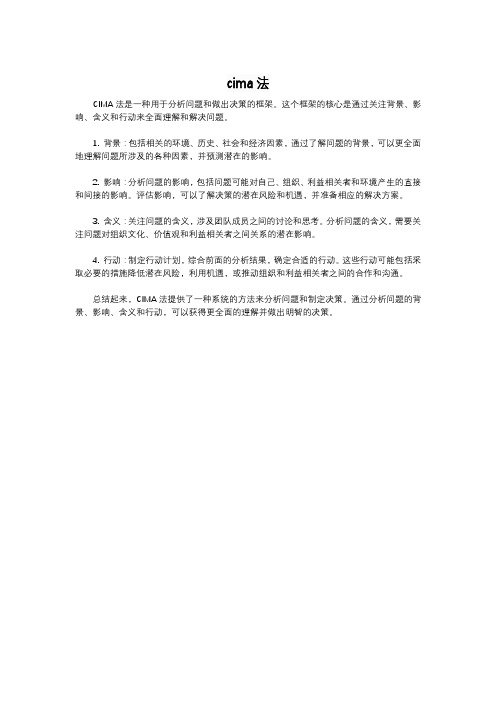
cima法
CIMA法是一种用于分析问题和做出决策的框架。
这个框架的核心是通过关注背景、影响、含义和行动来全面理解和解决问题。
1. 背景:包括相关的环境、历史、社会和经济因素,通过了解问题的背景,可以更全面地理解问题所涉及的各种因素,并预测潜在的影响。
2. 影响:分析问题的影响,包括问题可能对自己、组织、利益相关者和环境产生的直接和间接的影响。
评估影响,可以了解决策的潜在风险和机遇,并准备相应的解决方案。
3. 含义:关注问题的含义,涉及团队成员之间的讨论和思考。
分析问题的含义,需要关注问题对组织文化、价值观和利益相关者之间关系的潜在影响。
4. 行动:制定行动计划,综合前面的分析结果,确定合适的行动。
这些行动可能包括采取必要的措施降低潜在风险,利用机遇,或推动组织和利益相关者之间的合作和沟通。
总结起来,CIMA法提供了一种系统的方法来分析问题和制定决策。
通过分析问题的背景、影响、含义和行动,可以获得更全面的理解并做出明智的决策。
数学建模案例分析-2009年D题“会议筹备”

为了保持问题的原汁原味, 2009年全国大学生数学建 模竞赛D题中附表1和附图所列的10家宾馆的基本数据和 相对位置是真实的, 只是在各种客房和会议室的数量上 略作改动. 附表2中的数据来自本届会议的代表回执中有 关住房要求的信息. 附表3中所列的关于前几届会议的代 表回执和与会情况也基本上参考了历史数据.
NORTH UNIVERSITY OF CHINA
大 学 数 学 建 模 竞 赛 系 列 讲 座
案例分析—2009D“会议筹备”
主讲:薛震
2012年4月13日星期五
案例分析—2009D“会议筹备”
主讲:薛震
2012年4月13日星期五
确定需要预订客房的总量时,应该考虑使会议筹备组 在订房上的损失尽量小, 损失包括两部分: 预订客房数超 过实际用量时筹备组需要支付的一天空房费; 预订客房 数不够实际用量时引起代表不满的“费用”, 后者要用适当 的数学表达式加以量化.确定了预订客房的总量, 根据附 表2数据中本届会议的代表所需要三种类型的客房的比 例,可以得到需要预定各类客房的数量.
大 学 数 学 建 模 竞 赛 系 列 讲 座
NORTH UNIVERSITY OF CHINA
大 学 数 学 建 模 竞 赛 系 列 讲 座
案例分析—2009D“会议筹备”
主讲:薛震
2012年4月13日星期五
案例分析—2009D“会议筹备”
主讲:薛震
2012年4月13日星期五
问题3主要应考虑租用会议室和客车的总费用尽量小、 会议室所在的宾馆总数尽量少、距离上尽量靠近等.租车 接送代表要考虑多少代表参加哪个分组会议,由于题目中 没有这方面的信息,可以按照平均的、随机的方式处理. 当建立优化模型时,通常用租借会议室和客车的总费用 最少为目标,以满足对会议室数量和大小的需求, 及租车 接送代表的需要等为约束条件,由最优解确定租用哪些会 议室、三种车各租多少辆.
信息检索练习题(1)
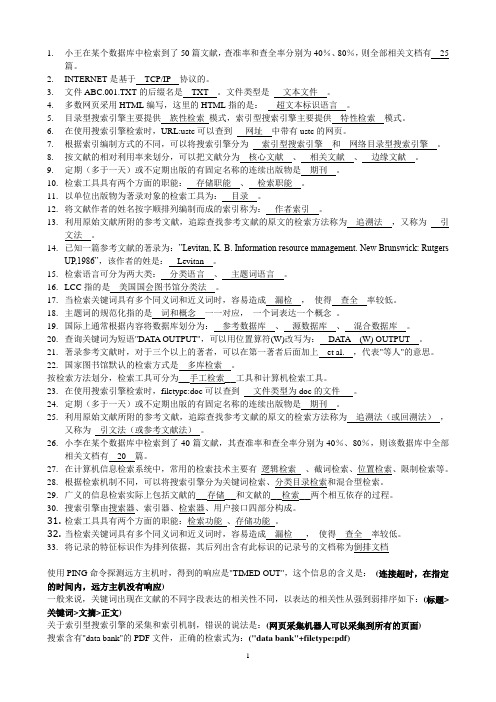
1.小王在某个数据库中检索到了50篇文献,查准率和查全率分别为40%、80%,则全部相关文档有25篇。
2.INTERNET是基于TCP/IP 协议的。
3.文件ABC.001.TXT的后缀名是TXT 。
文件类型是文本文件。
4.多数网页采用HTML编写,这里的HTML指的是:超文本标识语言。
5.目录型搜索引擎主要提供族性检索模式,索引型搜索引擎主要提供特性检索模式。
6.在使用搜索引擎检索时,URL:ustc可以查到网址中带有ustc的网页。
7.根据索引编制方式的不同,可以将搜索引擎分为索引型搜索引擎和网络目录型搜索引擎。
8.按文献的相对利用率来划分,可以把文献分为核心文献、相关文献、边缘文献。
9.定期(多于一天)或不定期出版的有固定名称的连续出版物是期刊。
10.检索工具具有两个方面的职能:存储职能、检索职能。
11.以单位出版物为著录对象的检索工具为:目录。
12.将文献作者的姓名按字顺排列编制而成的索引称为:作者索引。
13.利用原始文献所附的参考文献,追踪查找参考文献的原文的检索方法称为追溯法,又称为引文法。
14.已知一篇参考文献的著录为:”Levitan, K. B. Information resource management. New Brunswick: RutgersUP,1986”,该作者的姓是:Levitan 。
15.检索语言可分为两大类:分类语言、主题词语言。
16.LCC指的是美国国会图书馆分类法。
17.当检索关键词具有多个同义词和近义词时,容易造成漏检,使得查全率较低。
18.主题词的规范化指的是词和概念一一对应,一个词表达一个概念。
19.国际上通常根据内容将数据库划分为:参考数据库、源数据库、混合数据库。
20.查询关键词为短语"DA TA OUTPUT",可以用位置算符(W)改写为:DA TA(W) OUTPUT 。
21.著录参考文献时,对于三个以上的著者,可以在第一著者后面加上et al. ,代表"等人"的意思。
大学生信息检索习题以及答案

《大学生信息检索概论》模拟试题一、填空题1、文献的级次分为零次文献、一次文献、二次文献、三次文献2、《中图法》有五个基本部类,分别是马克思主义、列宁主义、毛泽东思想_、哲学;社会科学;自然科学和综合性图书,在此基础上又划分为_22_个大类。
3、按内容可将计算机检索系统的数据库类型分为:文献书目型数据库、事实型数据库、数值型数据库和全文型数据库。
4、我国标准可分为国家标准、部标准和企业标准三大类。
5、在实际检索中,文献的检索方法主要有:直查法、追溯法、工具法和综合法。
6、国际标准化组织简称:ISO 、本标准每 5 年修订一次二、选择题1、如果需要检索某位作者的文献被引用的情况,应该使用( C )检索。
A.分类索引B.作者索引C.引文索引 D.主题索引2、利用图书馆的据库检索期刊论文时,可供选择的中文数据库是( D )。
A.超星数字图书馆 B.万方学位论文 C.国研网 D.维普科技期刊 E.高校财经库3、如果检索有关多媒体网络传播方面的文献,检索式为(A D)。
A.多媒体and 网络传播 B.多媒体+网络传播 C.多媒体or 网络传播D.多媒体*网络传播4、如果对某个课题进行主题检索时,可选择的检索字段有( A D E )。
A.关键词 B.作者 C.刊名 D.题名 E.文摘5、二次文献又称检索工具,包括:( A C D )。
A.书目B.百科C.索引D.文摘E.统计数据三、名词解释题1、文献用文字、图形、符号、声频、视频等技术手段记录人类知识的一种载体,或理解为固化在一定物质载体上的知识。
也可以理解为古今一切社会史料的总称。
2、体系分类语言体系语言是以科学分类为基础,运用概念的划分与概括的逻辑方法,形成一个概念等级体系,按知识门类的逻辑次序,按照从总到分,从一般到具体,从低级到高级,从简单到复杂的原则进行概念的综分,层层划分,累累隶属,逐步展开而形成的一个等级体系。
3、引文语言引文语言是根据文献所附参考或引用文献的特征进行检索的语言。
PRISMA 2009 Checklist

Reported on page #
RESULTS
Study selection Study characteristics Risk of bias within studies Results of individual studies Synthesis of results Risk of bias across studies Additional analysis 17 18 19 20 21 22 23 Give numbers of studies screened, assessed for eligibility, and included in the review, with reasons for exclusions at each stage, ideally with a flow diagram. For each study, present characteristics for which data were extracted (e.g., study size, PICOS, follow-up period) and provide the citations. Present data on risk of bias of each study and, if available, any outcome level assessment (see item 12). For all outcomes considered (benefits or harms), present, for each study: (a) simple summary data for each intervention group (b) effect estimates and confidence intervals, ideally with a forest plot. Present results of each meta-analysis done, including confidence intervals and measures of consistency. Present results of any assessment of risk of bias across studies (see Item 15). Give results of additional analyses, if done (e.g., sensitivity or subgroup analyses, meta-regression [see Item 16]).
会计学cima专业课

会计学cima专业课会计学CIMA专业课是CIMA认证过程中的核心课程,涵盖了从基础到高级的各个方面。
这些课程包括会计原理、财务会计、Integrated English Skills、BA1 Fundamentals of Business Economics商业经济基础、BA2 Fundamentals of Management Accounting管理会计基础、BA3 Fundamentals of Financial Accounting财务会计基础、BA4 Fundamentals of Ethics, Corporate Governance and Business Law道德、公司治理与商法基础、E1 Organizational Management组织管理、P1 Management Accounting管理会计、F1 Financial Reporting and Taxation财务报告与税务、Operational Case Study运营案例、E2 Project and Relationship Management项目与关系管理、P2 Advanced Management Accounting高级管理会计、F2 Advanced Financial Reporting高级财务报告、Management Case Study 管理案例等。
这些课程不仅介绍了会计学的基本理论和基本知识,还包括管理会计的案例分析训练,让学生掌握会计核算、成本管理、预算规划、投资理财、管理控制等相关知识。
此外,这些课程还强调理论与实践相结合的能力,学生需要具备语言和文字表达能力、获取信息和人际沟通能力,以适应国际国内经济管理领域的工作需要。
通过这些课程的学习,学生可以掌握会计学的最新知识,提高自己的专业技能,为未来的职业生涯做好准备。
同时,这些课程还可以帮助学生获得CIMA认证,成为具有国际视野的优秀会计师。
CIMA2009Scenarios
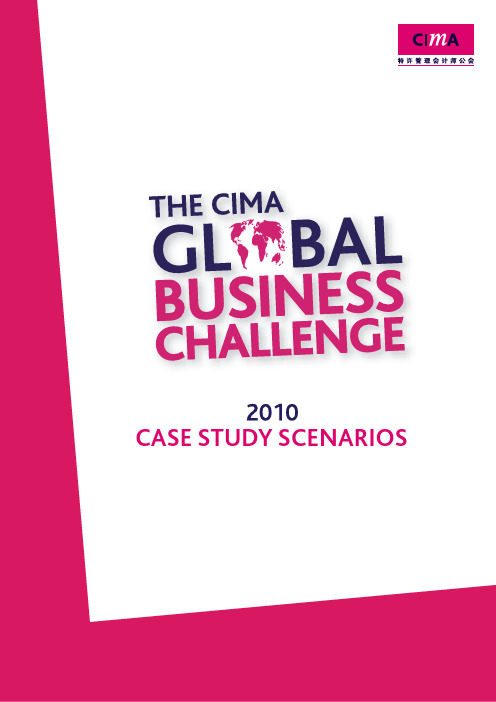
At the end of 2008, the global financial crisis swept down several leading finance countries suddenly and overwhelmingly, which might possibly lead to late – 2000s recession. The Dizz board has reviewed the approved 5 – year plan shown in appendix 4 of the pre – seen material and has communicated the range of amendment in some of the key figures and growth rate as a result of the possible decrease in demand with market analysts and also its own shareholders.
One of those hospitals has recently requested Dizz to increase the number of employees seconded to 15 person years each year.
To reduce the costs of outsourcing.
There are some changes in the underlying data which will have an effect on the planned profit figure for the 5 – year planning period. These are as follows:
CIA大纲2009年英文版本
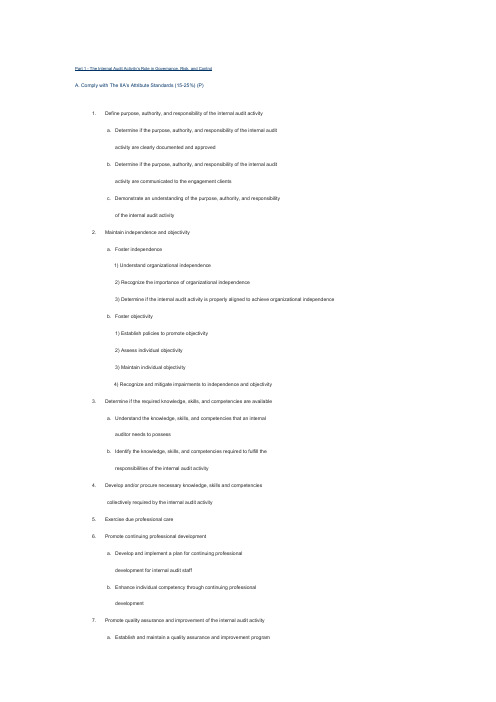
Part 1 - The Internal Audit Activity's Role in Governance, Risk, and ControlA. Comply with The IIA's Attribute Standards (15-25%) (P)1. Define purpose, authority, and responsibility of the internal audit activitya. Determine if the purpose, authority, and responsibility of the internal auditactivity are clearly documented and approvedb. Determine if the purpose, authority, and responsibility of the internal auditactivity are communicated to the engagement clientsc. Demonstrate an understanding of the purpose, authority, and responsibilityof the internal audit activity2. Maintain independence and objectivitya. Foster independence1) Understand organizational independence2) Recognize the importance of organizational independence3) Determine if the internal audit activity is properly aligned to achieve organizational independenceb. Foster objectivity1) Establish policies to promote objectivity2) Assess individual objectivity3) Maintain individual objectivity4) Recognize and mitigate impairments to independence and objectivity3. Determine if the required knowledge, skills, and competencies are availablea. Understand the knowledge, skills, and competencies that an internalauditor needs to possessb. Identify the knowledge, skills, and competencies required to fulfill theresponsibilities of the internal audit activity4. Develop and/or procure necessary knowledge, skills and competenciescollectively required by the internal audit activity5. Exercise due professional care6. Promote continuing professional developmenta. Develop and implement a plan for continuing professionaldevelopment for internal audit staffb. Enhance individual competency through continuing professionaldevelopment7. Promote quality assurance and improvement of the internal audit activitya. Establish and maintain a quality assurance and improvement programb. Monitor the effectiveness of the quality assurance and improvementprogramc. Report the results of the quality assurance and improvement programto the board or other governing bodyd. Conduct quality assurance procedures and recommend improvementsto the performance of the internal audit activity8. Abide by and promote compliance with The IIA Code of EthicsB. Establish a Risk-based Plan to Determine the Priorities of the Internal Audit Activity (15-25%) (P)1. Establish a framework for assessing risk2. Use the framework to:a. Identify sources of potential engagements (e.g., audit universe,management request, regulatory mandate)b. Assess organization-wide riskc. Solicit potential engagement topics from various sourcesd. Collect and analyze data on proposed engagementse. Rank and validate risk priorities3. Identify internal audit resource requirements4. Coordinate the internal audit activity's efforts with:a. External auditorb. Regulatory oversight bodiesc. Other internal assurance functions (e.g., health and safety department)5. Select engagements.a. Participate in the engagement selection processb. Select engagementsc. Communicate and obtain approval of the engagement plan from boardC. Understand the Internal Audit Activity's Role in Organizational Governance (10-20%) (P)1. Obtain board's approval of audit charter2. Communicate plan of engagements3. Report significant audit issues4. Communicate key performance indicators to board on a regular basis5. Discuss areas of significant risk6. Support board in enterprise-wide risk assessment7. Review positioning of the internal audit function within the risk management framework within the organization8. Monitor compliance with the corporate code of conduct/business practices9. Report on the effectiveness of the control framework10. Assist board in assessing the independence of the external auditor11. Assess ethical climate of the board12. Assess ethical climate of the organization13. Assess compliance with policies in specific areas (e.g., derivatives)14. Assess organization's reporting mechanism to the board15. Conduct follow-up and report on management response to regulatory body reviews16. Conduct follow-up and report on management response to external audit17. Assess the adequacy of the performance measurement system, achievement of corporate objective18. Support a culture of fraud awareness and encourage the reporting of improprietiesD. Perform Other Internal Audit Roles and Responsibilities (0-10%) (P)1. Ethics/Compliancea. Investigate and recommend resolution for ethics/compliance complaintsb. Determine disposition of ethics violationsc. Foster healthy ethical climated. Maintain and administer business conduct policy (e.g., conflict of interest)e. Report on compliance2. Risk Managementa. Develop and implement an organization-wide risk and control frameworkb. Coordinate enterprise-wide risk assessmentc. Report corporate risk assessment to boardd. Review business continuity planning process3. Privacya. Determine privacy vulnerabilitiesb. Report on compliance4. Information or physical securitya. Determine security vulnerabilitiesb. Determine disposition of security violationsc. Report on complianceE. Governance, Risk, and Control Knowledge Elements (15-25%)1. Corporate governance principles (A)2. Alternative control frameworks (A)3. Risk vocabulary and concepts (P)4. Risk management techniques (P)5. Risk/control implications of different organizational structures (P)6. Risk/control implications of different leadership styles (A)7. Change management (A)8. Conflict management (A)9. Management control techniques (P)10. Types of control (e.g., preventive, detective, input, output) (P)F. Plan Engagements (15-25%) (P)1. Initiate preliminary communication with engagement client2. Conduct a preliminary survey of the area of engagementa. Obtain input from engagement clientb. Perform analytical reviewsc. Perform benchmarkingd. Conduct interviewse. Review prior audit reports and other relevant documentationf. Map processesg. Develop checklists3. Complete a detailed risk assessment of the area (prioritize or evaluate risk/control factors)4. Coordinate audit engagement efforts witha. External auditorb. Regulatory oversight bodies5. Establish/refine engagement objectives and identify/finalize the scope of engagement6. Identify or develop criteria for assurance engagements (criteria against which to audit)7. Consider the potential for fraud when planning an engagementa. Be knowledgeable of the risk factors and red flags of fraudb. Identify common types of fraud associated with the engagement areac. Determine if risk of fraud requires special consideration whenconducting an engagement8. Determine engagement procedures9. Determine the level of staff and resources needed for the engagement10. Establish adequate planning and supervision of the engagement11. Prepare engagement work programPart 2 - Conducting the Internal Audit EngagementA. Conduct Engagements (25-35%) (P)1. Research and apply appropriate standards:a. IIA Professional Practices Framework (Code of Ethics, Standards,Practice Advisories)b. Other professional, legal, and regulatory standards2. Maintain an awareness of the potential for fraud when conducting an engagementa. Notice indicators or symptoms of fraudb. Design appropriate engagement steps to address significant riskof fraudc. Employ audit tests to detect fraudd. Determine if any suspected fraud merits investigation3. Collect data4. Evaluate the relevance, sufficiency, and competence of evidence5. Analyze and interpret data6. Develop work papers7. Review work papers8. Communicate interim progress9. Draw conclusions10. Develop recommendations when appropriate11. Report engagement resultsa. Conduct exit conferenceb. Prepare report or other communicationc. Approve engagement reportd. Determine distribution of reporte. Obtain management response to report12. Conduct client satisfaction survey13. Complete performance appraisals of engagement staffB. Conduct Specific Engagements (25-35%) (P)1. Conduct assurance engagementsa. Fraud investigation1) Determine appropriate parties to be involved with investigation2) Establish facts and extent of fraud (e.g., interviews, interrogationsand data analysis)3) Report outcomes to appropriate parties4) Complete a process review to improve controls to prevent fraudand recommend changesb. Risk and control self-assessment1) Facilitated approach(a) Client-facilitated(b) Audit-facilitated2) Questionnaire approach3) Self-certification approachc. Audits of third parties and contract auditingd. Quality audit engagementse. Due diligence audit engagementsf. Security audit engagementsg. Privacy audit engagementsh. Performance (key performance indicators) audit engagementsi. Operational (efficiency and effectiveness) audit engagementsj. Financial audit engagementsk. Information technology (IT) audit engagements1) Operating systems(a) Mainframe(b) Workstations(c) Server2) Application development(a) Application authentication(b) Systems development methodology(c) Change control(d) End user computing3) Data and network communications/connections (e.g., LAN, VAN,and WAN)4) Voice communications5) System security (e.g., firewalls, access control)6) Contingency planning7) Databases8) Functional areas of IT operations (e.g., data center operations)9) Web infrastructure10) Software licensing11) Electronic funds transfer (EFT)/Electronic data interchange (EDI)12) e-Commerce13) Information protection (e.g., viruses, privacy)14) Encryption15) Enterprise-wide resource planning (ERP) software (e.g., SAP R/3)l. Compliance audit engagements2. Conduct consulting engagementsa. Internal control trainingb. Business process reviewc. Benchmarkingd. Information technology (IT) and systems developmente. Design of performance measurement systemsC. Monitor Engagement Outcomes (5-15%) (P)1. Determine appropriate follow-up activity by the internal audit activity2. Identify appropriate method to monitor engagement outcomes3. Conduct follow-up activity4. Communicate monitoring plan and resultsD. Fraud Knowledge Elements (5-15%)1. Discovery sampling (A)2. Interrogation techniques (A)3. Forensic auditing (A)4. Use of computers in analyzing data (P)5. Red flag (P)6. Types of fraud (P)E. Engagement Tools (15-25%)1. Sampling (A)a. Nonstatistical (judgmental)b. Statistical2. Statistical analyses (process control techniques) (A)3. Data gathering tools (P)a. Interviewingb. Questionnairesc. Checklists4. Analytical review techniques (P)a. Ratio estimationb. Variance analysis (e.g., budget vs. actual)c. Other reasonableness tests5. Observation (P)6. Problem solving (P)7. Risk and control self-assessment (CSA) (A)8. Computerized audit tools and techniques (P)a. Embedded audit modulesb. Data extraction techniquesc. Generalized audit software (e.g., ACL, IDEA)d. Spreadsheet analysise. Automated work papers (e.g., Lotus Notes, Auditor Assistant)9. Process mapping including flowcharting (P)Part 3 - Business Analysis and Information TechnologyA. Business Processes (15-25%)1. Quality management (e.g., TQM) (A)2. The International Organization for Standardization (ISO) framework (A)3. Forecasting (A)4. Project management techniques (P)5. Business process analysis (e.g., workflow analysis and bottleneck management, theory of constraints) (P)6. Inventory management techniques and concepts (P)7. Marketing - pricing objectives and policies (A)8. Marketing - supply chain management (A)9. Human Resources (Individual performance management and measurement; supervision; environmental factors that affectperformance; facilitation techniques; personnel sourcing/staffing; training and development; safety) (P)10. Balanced scorecard (A)B. Financial Accounting and Finance (15-25%)1. Basic concepts and underlying principles of financial accounting (e.g., statements, terminology, relationships) (P)2. Intermediate concepts of financial accounting (e.g., bonds, leases, pensions, intangible assets, R&D) (A)3. Advanced concepts of financial accounting (e.g., consolidation, partnerships, foreign currency transactions) (A)4. Financial statement analysis (P)5. Cost of capital evaluation (A)6. Types of debt and equity (A)7. Financial instruments (e.g., derivatives) (A)8. Cash management (treasury functions) (A)9. Valuation models (A)a. Inventory valuationb. Business valuation10. Business development life cycles (A)C. Managerial Accounting (10-20%)1. Cost concepts (e.g., absorption, variable, fixed) (P)2. Capital budgeting (A)3. Operating budget (P)4. Transfer pricing (A)5. Cost-volume-profit analysis (A)6. Relevant cost (A)7. Costing systems (e.g., activity-based, standard) (A)8. Responsibility accounting (A)D. Regulatory, Legal, and Economics (5-15%) (A)1. Impact of government legislation and regulation on business2. Trade legislation and regulations3. Taxation schemes4. Contracts5. Nature and rules of legal evidence6. Key economic indicatorsE. Information Technology - IT (30-40%) (A)1. Control frameworks (e.g., COBIT)2. Data and network communications/connections (e.g., LAN, VAN, and WAN)3. Electronic funds transfer (EFT)4. e-Commerce5. Electronic data interchange (EDI)6. Functional areas of IT operations (e.g., data center operations)7. Encryption8. Information protection (e.g. viruses, privacy)9. Evaluate investment in IT (cost of ownership)10. Enterprise-wide resource planning (ERP) software (e.g., SAP R/3)11. Operating systems12. Application development13. Voice communications14. Contingency planning15. Systems security (e.g. firewalls, access control)16. Databases17. Software licensing18. Web infrastructureP=Candidates must exhibit proficiency (thorough understanding and ability to apply concepts) in these topic areas. A=Candidates must exhibit awareness (knowledge of terminology and fundamentals) in these topic areas.Part 4 - Business Management SkillsA. Strategic Management (20-30%) (A)1. Global analytical techniquesa. Structural analysis of industriesb. Competitive strategies (e.g., Porter's model)c. Competitive analysisd. Market signalse. Industry evolution2. Industry environmentsa. Competitive strategies related to:1) Fragmented industries2) Emerging industries3) Declining industriesb. Competition in global industries1) Sources/impediments2) Evolution of global markets3) Strategic alternatives4) Trends affecting competition3. Strategic decisionsa. Analysis of integration strategiesb. Capacity expansionc. Entry into new businesses4. Portfolio techniques of competitive analysis5. Product life cyclesB. Global Business Environments (15-25%) (A)1. Cultural/legal/political environmentsa. Balancing global requirements and local imperativesb. Global mindsets (personal characteristics/competencies)c. Sources and methods for managing complexities and contradictionsd. Managing multicultural teams2. Economic/financial environmentsa. Global, multinational, international, and multilocal compared and contrastedb. Requirements for entering the global market placec. Creating organizational adaptabilityd. Managing training and developmentC. Organizational Behavior (15-25%) (A)1. Motivationa. Relevance and implication of various theoriesb. Impact of job design, rewards, work schedules, etc.2. Communicationa. The processb. Organizational dynamicsc. Impact of computerization3. Performancea. Productivityb. Effectiveness4. Structurea. Centralized/decentralizedb. Departmentalizationc. New configurations (e.g., hourglass, cluster, network)D. Management Skills (20-30%) (A)1. Group dynamicsa. Traits (e.g., cohesiveness, roles, norms, groupthink)b. Stages of group developmentc. Organizational politicsd. Criteria and determinants of effectiveness2. Team buildinga. Methods used in team buildingb. Assessing team performance3. Leadership skillsa. Theories compared and contrastedb. Leadership grid (topology of leadership styles)c. Mentoring4. Personal time managementE. Negotiating (5-15%) (A)1. Conflict resolutiona. Competitive/cooperativeb. Compromise, forcing, smoothing, etc.2. Added-value negotiatinga. Descriptionb. Specific stepsP=Candidates must exhibit proficiency (thorough understanding and ability to apply concepts) in these topic areas. A=Candidates must exhibit awareness (knowledge of terminology and fundamentals) in these topic areas.。
2009年高教杯数学建模一等奖论文
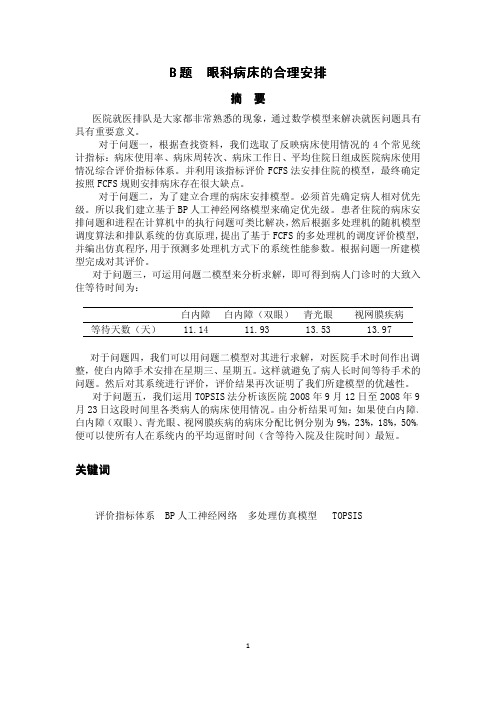
对于问题五,我们运用 TOPSIS 法分析该医院 2008 年 9 月 12 日至 2008 年 9 月 23 日这段时间里各类病人的病床使用情况。由分析结果可知:如果使白内障、 白内障(双眼)、青光眼、视网膜疾病的病床分配比例分别为 9%,23%,18%,50%, 便可以使所有人在系统内的平均逗留时间(含等待入院及住院时间)最短。
而对于低优指标则相反(平均住院日),分值越小,编秩越高,表明评价期该指 标优于标准值。 1.病床使用率
病床使用率是反映每天使用床位与实有床位的比率,即实际占用的总床日数 与实际开放的总床日数之比。如下公式所示
病床使用率
=
实际占用总床日数 实际开放总床日数
×100%
即:
β = d1 ×100% d2
实际占用总床日数等于 2008 年 7 月 13 日到 9 月 11 日这 60 天内所有患者占
即: CF= n m
由附录可知在考察的 60 天内总共有 349 人出院即 n=349,由已知可知该医院 开放病床数为 79 张即 m=79,由此可得到病床周转次数。
5
3.平均病床工作日 平均病床工作日 ,反映医院工作质量指标之一。指每一张床在一定时期内
平均工作的日数,用以衡量病床的利用情况
平均病床工作日= 统计期内占用总床日数 平均开放病床数
《信息检索与应用》总复习题
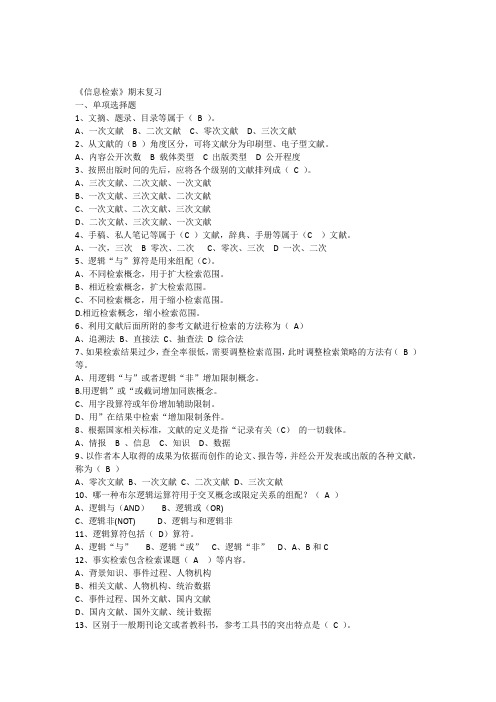
《信息检索》期末复习一、单项选择题1、文摘、题录、目录等属于(B )。
A、一次文献B、二次文献C、零次文献D、三次文献2、从文献的(B )角度区分,可将文献分为印刷型、电子型文献。
A、内容公开次数 B 载体类型 C 出版类型 D 公开程度3、按照出版时间的先后,应将各个级别的文献排列成(C )。
A、三次文献、二次文献、一次文献B、一次文献、三次文献、二次文献C、一次文献、二次文献、三次文献D、二次文献、三次文献、一次文献4、手稿、私人笔记等属于(C )文献,辞典、手册等属于(C )文献。
A、一次,三次 B 零次、二次C、零次、三次 D 一次、二次5、逻辑“与”算符是用来组配(C)。
A、不同检索概念,用于扩大检索范围。
B、相近检索概念,扩大检索范围。
C、不同检索概念,用于缩小检索范围。
D.相近检索概念,缩小检索范围。
6、利用文献后面所附的参考文献进行检索的方法称为(A)A、追溯法B、直接法C、抽查法D 综合法7、如果检索结果过少,查全率很低,需要调整检索范围,此时调整检索策略的方法有(B )等。
A、用逻辑“与”或者逻辑“非”增加限制概念。
B.用逻辑”或“或截词增加同族概念。
C、用字段算符或年份增加辅助限制。
D、用”在结果中检索“增加限制条件。
8、根据国家相关标准,文献的定义是指“记录有关(C)的一切载体。
A、情报 B 、信息C、知识D、数据9、以作者本人取得的成果为依据而创作的论文、报告等,并经公开发表或出版的各种文献,称为(B )A、零次文献B、一次文献C、二次文献D、三次文献10、哪一种布尔逻辑运算符用于交叉概念或限定关系的组配?(A )A、逻辑与(AND)B、逻辑或(OR)C、逻辑非(NOT)D、逻辑与和逻辑非11、逻辑算符包括(D)算符。
A、逻辑“与”B、逻辑“或”C、逻辑“非”D、A、B和C12、事实检索包含检索课题(A )等内容。
A、背景知识、事件过程、人物机构B、相关文献、人物机构、统治数据C、事件过程、国外文献、国内文献D、国内文献、国外文献、统计数据13、区别于一般期刊论文或者教科书,参考工具书的突出特点是(C )。
cima大一知识点

cima大一知识点CIMA 大一知识点CIMA(特许管理会计师)是全球领先的管理会计师认证机构,其认证课程包含了一系列知识点,帮助从业者掌握财务和战略管理的技能。
本文将介绍 CIMA 大一认证课程中的主要知识点,以帮助读者了解这一认证的概况和内容。
第一章: 经营环境(Business Environment)在这一章节中,学习者将了解到企业经营所面临的环境因素,包括经济、社会、政治和法律等方面的因素。
他们将研究市场结构、竞争力分析以及宏观经济的指标,并学习利用这些因素来制定战略计划。
第二章: 组织结构与管理(Organizational Structure and Management)这一章节将向学习者介绍不同类型的组织结构,如功能型、事业部型和矩阵型等,以及各种类型的管理和领导风格。
学习者将学习如何分析组织结构的优势和劣势,并能够设计有效的组织结构以支持企业战略。
第三章: 企业道德与社会责任(Corporate Ethics and Social Responsibility)企业道德和社会责任对于企业的可持续发展至关重要。
学习者将了解到伦理决策的原则和框架,以及企业应对社会责任的方法和实践。
他们还将研究企业社会责任对于企业形象和声誉的影响,以及如何利用社会责任来获得竞争优势。
第四章: 市场营销与客户关系管理(Marketing and Customer Relationship Management)市场营销是企业获取和维护客户的关键活动。
学习者将学习市场营销的基本概念和战略,包括市场细分、目标市场选择、产品定价和销售渠道等。
他们还将了解客户关系管理的重要性,并学习如何建立和维护良好的客户关系。
第五章: 财务会计基础(Fundamentals of Financial Accounting)财务会计是管理会计的基础,主要涉及企业财务报表的编制和分析。
学习者将学习公司会计准则、会计方程和核算方法,以及如何编制资产负债表、利润表和现金流量表等财务报表。
国外 医学预测模型教材
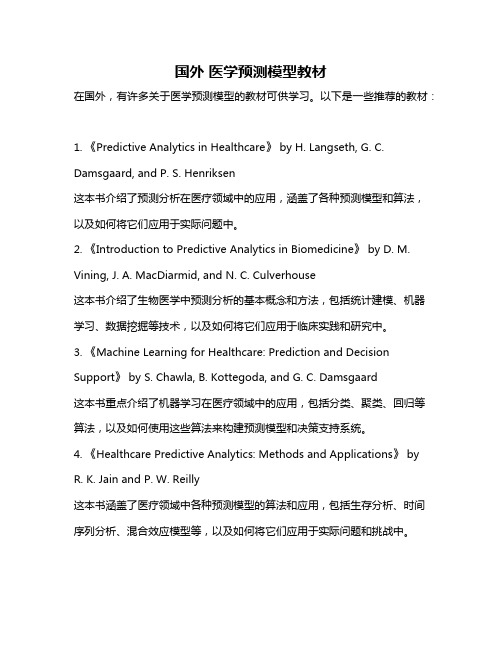
国外医学预测模型教材
在国外,有许多关于医学预测模型的教材可供学习。
以下是一些推荐的教材:
1. 《Predictive Analytics in Healthcare》 by H. Langseth, G. C. Damsgaard, and P. S. Henriksen
这本书介绍了预测分析在医疗领域中的应用,涵盖了各种预测模型和算法,以及如何将它们应用于实际问题中。
2. 《Introduction to Predictive Analytics in Biomedicine》 by D. M. Vining, J. A. MacDiarmid, and N. C. Culverhouse
这本书介绍了生物医学中预测分析的基本概念和方法,包括统计建模、机器学习、数据挖掘等技术,以及如何将它们应用于临床实践和研究中。
3. 《Machine Learning for Healthcare: Prediction and Decision Support》 by S. Chawla, B. Kottegoda, and G. C. Damsgaard
这本书重点介绍了机器学习在医疗领域中的应用,包括分类、聚类、回归等算法,以及如何使用这些算法来构建预测模型和决策支持系统。
4. 《Healthcare Predictive Analytics: Methods and Applications》 by R. K. Jain and P. W. Reilly
这本书涵盖了医疗领域中各种预测模型的算法和应用,包括生存分析、时间序列分析、混合效应模型等,以及如何将它们应用于实际问题和挑战中。
这些教材都是权威性的经典之作,可以帮助您深入了解医学预测模型的基本概念、方法和应用。
大数据环境下印度留学生病理学网络教学

大数据环境下印度留学生病理学网络教学发表时间:2019-10-30T17:22:31.963Z 来源:《教育学文摘》2019年12月总第322期作者:李佳王宝菊吕自力庞玉艳(通讯作者)[导读] 从而阐明疾病本质的医学过渡科学,它是医学基础与临床过渡的桥梁,是从细胞层面研究疾病本质的学科。
广西医科大学第一附属医院病理科广西南宁530000摘要:随着大数据时代的到来,网络信息技术飞速发展,中国各高校对大学生的教育方式和人才培养方式发生了巨大改变。
信息时代的网络教学给师生带来诸多方便和利益,具有独特的优势,同时也让教育界面临新的发展机遇和挑战。
本文主要针对2017级全英班留学生病理学教学,利用网络平台和网络软件,提出并试用新的教学方式,达到提高教学效率和质量的目的。
关键词:留学生病理学网络病理学是用自然科学的方法,研究疾病发生的原因、发病机制、形态结构、功能和代谢等方面的改变,揭示疾病的发生发展规律,从而阐明疾病本质的医学过渡科学,它是医学基础与临床过渡的桥梁,是从细胞层面研究疾病本质的学科。
基于这些学科特点,病理学与其他学科相比,具有抽象、组织结构复杂、知识点琐碎、专业名词多等特点,导致学生学习病理时难以理解和把握重点和难点,记忆困难。
随着我国教育事业的进步和发展,来我国学习的留学生越来越多。
关于留学生的本科教育问题引起各高校的关注及重视,将网络教学应用于全英班印度留学生的病理学教学实践中,是我校教育方式改革的一大创新。
实践证明,将信息网络技术运用于留学生病理学教学,有助于学生对知识的理解掌握和学习成绩的提高。
一、网络教学的具体实施方法1.课前准备学期开始时,通过微信扫码加好友,给带教的全英52班建立一个班级微信群和“雨课堂”平台,用于与学生的互动交流。
教师提前一周结合网络信息和教学大纲制作Power Point课件,课件内容主要包括图片、文字、动画、视频、习题等,这些习题主要是单项选择题。
此外,教师还可以定期将一些病理学趣味小文章、小知识点和相关病例等置入该平台,学生可以根据自己的需要和兴趣进行翻阅学习。
INSTITUTE CARGO CLAUSES (ICC2009)(A)
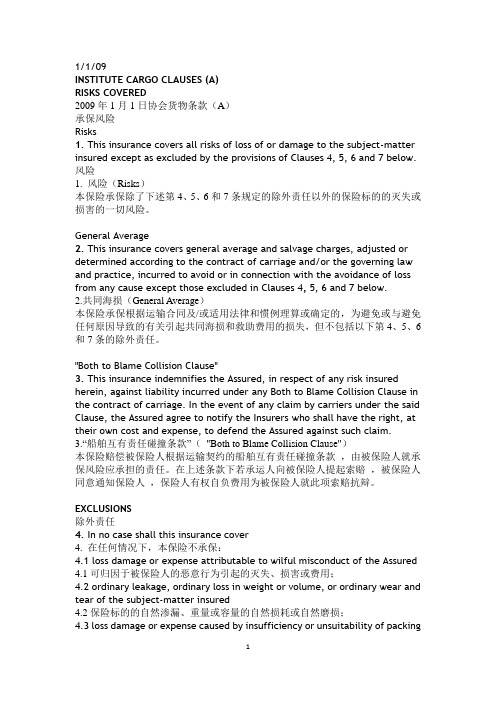
1/1/09INSTITUTE CARGO CLAUSES (A)RISKS COVERED2009年1月1日协会货物条款(A)承保风险Risks1. This insurance covers all risks of loss of or damage to the subject-matter insured except as excluded by the provisions of Clauses 4, 5, 6 and 7 below. 风险1. 风险(Risks)本保险承保除了下述第4、5、6和7条规定的除外责任以外的保险标的的灭失或损害的一切风险。
General Average2. This insurance covers general average and salvage charges, adjusted or determined according to the contract of carriage and/or the governing law and practice, incurred to avoid or in connection with the avoidance of loss from any cause except those excluded in Clauses 4, 5, 6 and 7 below.2.共同海损(General Average)本保险承保根据运输合同及/或适用法律和惯例理算或确定的,为避免或与避免任何原因导致的有关引起共同海损和救助费用的损失,但不包括以下第4、5、6和7条的除外责任。
"Both to Blame Collision Clause"3. This insurance indemnifies the Assured, in respect of any risk insured herein, against liability incurred under any Both to Blame Collision Clause in the contract of carriage. In the event of any claim by carriers under the said Clause, the Assured agree to notify the Insurers who shall have the right, at their own cost and expense, to defend the Assured against such claim.3.“船舶互有责任碰撞条款”("Both to Blame Collision Clause")本保险赔偿被保险人根据运输契约的船舶互有责任碰撞条款,由被保险人就承保风险应承担的责任。
2009年度CIA考试成绩一览表

赵丽颖 曹金电 杨勇 代垒垒 李平 高洪 孙晨 金红艳 李勇 徐海清 毕芳芳 赵丹丹 徐亦 马玲 张云 王鑫 胡彦 童学根 王丹 江健 傅晓红 李强 徐镇 汪波 詹荣水 郑东
Zhao Liying Cao Jindian Yang Yong Dai Leilei Li Ping Gao Hong Sun Chen Jin Hongyan Li Yong Xu Haiqing Bi Fangfang Zhao Dandan Xu Yi Ma Ling Zhang Yun Wang Xin Hu Yan Tong Xuegen Wang Dan Jiang Jian Fu Xiaohong Li Qiang Xu Zhen Wang Bo Zhan Rongshui PREVIOUSLY PASSED Zheng Dong PREVIOUSLY PASSED PREVIOUSLY PASSED PASSED PREVIOUSLY PASSED PREVIOUSLY PASSED PASSED PREVIOUSLY PASSED PASSED PREVIOUSLY PASSED PASSED PASSED
Shang Songling PASSED Qin Gaoxiang Ding Peng Tao Haibo PREVIOUSLY PASSED PREVIOUSLY PASSE1462565 1462568 1462570 1462572 1462573 1462575 1462580 1462582 1462585 1462586 1462587 1462589 1462590 1462593 1462594 1462596 1462597 1462600 1462601 1462602 1462603 1462610 1462616 1462618
cima 管理级 case study
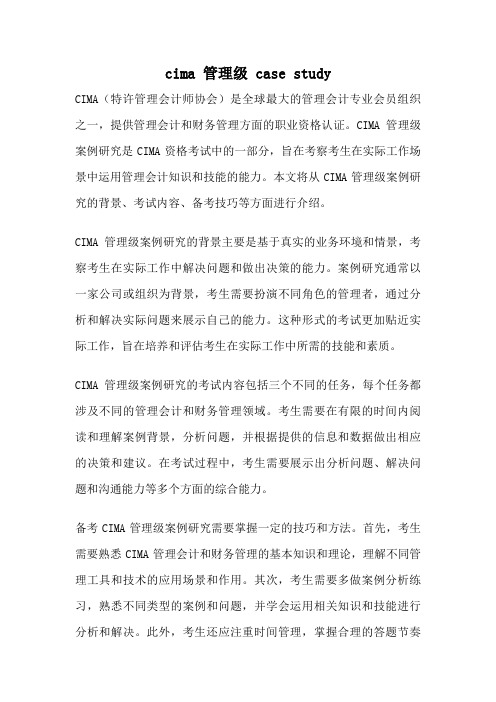
cima 管理级 case studyCIMA(特许管理会计师协会)是全球最大的管理会计专业会员组织之一,提供管理会计和财务管理方面的职业资格认证。
CIMA管理级案例研究是CIMA资格考试中的一部分,旨在考察考生在实际工作场景中运用管理会计知识和技能的能力。
本文将从CIMA管理级案例研究的背景、考试内容、备考技巧等方面进行介绍。
CIMA管理级案例研究的背景主要是基于真实的业务环境和情景,考察考生在实际工作中解决问题和做出决策的能力。
案例研究通常以一家公司或组织为背景,考生需要扮演不同角色的管理者,通过分析和解决实际问题来展示自己的能力。
这种形式的考试更加贴近实际工作,旨在培养和评估考生在实际工作中所需的技能和素质。
CIMA管理级案例研究的考试内容包括三个不同的任务,每个任务都涉及不同的管理会计和财务管理领域。
考生需要在有限的时间内阅读和理解案例背景,分析问题,并根据提供的信息和数据做出相应的决策和建议。
在考试过程中,考生需要展示出分析问题、解决问题和沟通能力等多个方面的综合能力。
备考CIMA管理级案例研究需要掌握一定的技巧和方法。
首先,考生需要熟悉CIMA管理会计和财务管理的基本知识和理论,理解不同管理工具和技术的应用场景和作用。
其次,考生需要多做案例分析练习,熟悉不同类型的案例和问题,并学会运用相关知识和技能进行分析和解决。
此外,考生还应注重时间管理,掌握合理的答题节奏和顺序,确保在规定时间内完成任务。
CIMA管理级案例研究是一个考察考生实际工作能力和综合素质的重要环节。
通过该项考试,CIMA能够评估考生在实际工作场景中应对问题和做出决策的能力,为其提供全球认可的管理会计资格认证。
备考CIMA管理级案例研究需要掌握相关知识和技能,并善于运用它们解决实际问题。
希望通过本文的介绍,读者对CIMA管理级案例研究有了更加全面的了解。
- 1、下载文档前请自行甄别文档内容的完整性,平台不提供额外的编辑、内容补充、找答案等附加服务。
- 2、"仅部分预览"的文档,不可在线预览部分如存在完整性等问题,可反馈申请退款(可完整预览的文档不适用该条件!)。
- 3、如文档侵犯您的权益,请联系客服反馈,我们会尽快为您处理(人工客服工作时间:9:00-18:30)。
2010 CASE STUDYDizz mobile phone caseMarket overviewSince mobile telephony was introduced in Europe in 1985, the market has grown at a far higher pace than was originally expected. Furthermore, mobile phones have reached all levels of the market place, with market saturation levels being achieved at a much earlier date than industry commentators had forecast. This has resulted in many European mobile phone network operators seeking new markets around the world where growth can still be achieved. Many European mobile phone network operators have become global companies with investments in mobile networks in many countries across several continents.A mobile phone network operator is defined as a company which has been issued with an operating licence by the respective government to operate a mobile phone network, at particular frequencies in the atmosphere owned by each country. The mobile phone network operator pays a licence fee to the respective government. The mobile phone network operator which has been granted a licence is responsible for the construction and operation of a mobile phone network. The network comprises thousands of transmitters (sometimes known as base stations) which transmit the signal from the mobile phone to the telephone network. A mobile phone network operator is also responsible for invoicing its customers for contracted revenues according to their usage of the network services. Within each country the mobile phone market is monitored by Regulatory Authorities appointed by each Government. These Regulatory Authorities have powers to influence pricing and encourage fair competition. The European market for mobile phones has changed dramatically over the last decade due to competitive pressures, which the Regulatory Authorities have encouraged.A customer is defined as the user of a single mobile phone handset. Customers have a choice in many European countries as to which mobile phone network operator to select. Their choice is determined by price, the range of the services provided and the perceived quality of the various mobile phone network operators. However, the deciding factor on customer loyalty and new connections is often based on the most suitable price package available to suit customers’ requirements. The choice of mobile phone handset is also a deciding factor. There is a high level of ‘churn’ in this industry. The ‘churn rate’ is defined as the number of customers who disconnect from a mobile phone network operator in a given period, divided by the average number of customers in that same period. In some European countries there are more mobile phone customers than there are people and this is called a ‘saturated’ market. There is now generally little difference between mobile phone network operators in terms of the quality of the signal and network coverage. Therefore mobile phone network operators face greater challenges in attempting to differentiate their services.The largest growth potential for new mobile phone customers is in the emerging markets, mainly in Asia. In India, for example, with a population of over 1,100 million, the number of mobile phone customers is currently only 15% of the population. Many of the large international mobile phone network operators are therefore targeting these emerging markets as a way to generate additional growth and ultimately to increase shareholder wealth.DizzDizz is an international mobile phone network operator, which is listed on a European stock exchange. It has operations in 17 countries across Europe, Africa and Asia. Dizz does not have any operations in the USA or the Australasian markets. Dizz was established in the mid 1980’s when mobile telephony was first launched in Europe, and was then a subsidiary of a landline telephony company. Dizz became a listed company during the 1990’s. It has since established or acquired a shareholding in a number of other mobile phone network operators.Dizz currently owns 100% of the shareholdings in mobile phone network operators in 3 European countries and also owns majority shareholdings in other European, Asian and African countries. Dizz has 214 million customers, in total, across all of its subsidiary and fully ownedcompanies. It attained group revenues of over €52,000 million in the financial year ended 30 June 2008.The Income Statement, Balance Sheet and Statement of Changes in Equity for Dizz for the last 2 financial years are shown in Appendix 1 on page 11. Dizz’s Statement of Cash Flows is shown in Appendix 2 on page 12.All of the financial and statistical data in respect of Dizz’s network operations represents the entire network and all of its customers. The minority interests are accounted for in the Income Statement and Balance Sheet in Appendix 1.In 7 European countries, as well as in all of the African and Asian countries in which it operates, Dizz holds a majority shareholding in the mobile phone operating company, as it is not allowed by the respective governments to hold a 100% shareholding. The fees for the licences which have been issued to Dizz for the 17 countries in which it operates are included in theNon-current assets in Dizz’s Balance Sheet, shown in Appendix 1. The licence fee cost is amortised over the period for which Dizz, and the consortium companies, have been granted the operating licences. None of the licences for the 17 countries in which Dizz operates are due to expire before June 2014.A summary of the Dizz group’s shareholdings and customer numbers, analysed by country, is shown below:Region Dizzshareholding Customer numbers (end June 2008)(Million)Europe - 3 countries 100% 69Europe - 7 other countries Majority 34Europe - Total of 10 countries 103Africa - 3 countries Majority 35Asia – 4 countries Majority 76Overall - total 17 countries 214Dizz’s organisation structureThe main Dizz Board is shown in Appendix 3 on page 13. Dizz has 12,600 employees in the companies in which it holds a 100% shareholding. In the other mobile phone networks around the world in which it has a majority shareholding, a further 6,500 are employed. Additionally, Dizz outsources a number of functions to a range of specialised outsourcing companies.The group is split into 3 divisions, geographically, with a Chief Executive Officer (CEO) managing each division. The 3 divisions are:•Europe•Africa•AsiaThe CEO of each of the 3 divisions has a seat on the main Dizz Board and is also responsible for all operations for the Dizz subsidiary companies in his geographical area. Within each division the CEO has a senior management team which is responsible for each of the mobile networks. The Dizz group’s annual and 5-year plans are prepared within each division, to encourage ownership and accountability. However, they have to be approved by the main DizzBoard. The main Dizz Board will also cascade down group objectives for growth, cost reduction, corporate social responsibility (CSR) and quality standards. Therefore, although the 5-year plans are produced by the management team within each division, these plans need to meet the overall objectives set by the Dizz Board.The Dizz Board has always been a strong believer in the importance of developing the company’s own management team. The Dizz management trainee scheme, which was first implemented in 1990, has been regularly enhanced to develop an experienced well trained pool of managers. Dizz wants to invest in its people, as the Group CEO is confident that in this way employees will have the power to influence the success of the company in this highly competitive environment. Only by investing in its employees’ welfare and continuous education can Dizz try to release each individual’s true potential to increase value for the group. The Dizz Board believes that by investing in training and development, both vocational and personal (such as development of language skills not directly related to the employee’s job responsibility), Dizz is improving the wider skill base of its employees. The Group CEO and HR Director both believe that trained employees will be highly motivated and will stay with Dizz for longer. Furthermore, the belief at a senior level is that these trained employees will not become complacent. Therefore they will provide Dizz’s customers with high quality customer service. This should ultimately deliver growth in shareholder wealth. The HR Director is continuing to work with his teams to create an environment within all areas of the group, across all countries, where staff can excel and be rewarded for their contribution.The Executive Directors and senior management teams across all 3 divisions receive performance related pay, based on added value principles. This is extremely difficult to measure. The group rewards senior employees using a range of performance measures. These measures include revenues, share price and customer numbers, as well as quality indicators, such as customer satisfaction, churn, and the introduction of new products and services.The Executive Directors all have share options which can be exercised at €24.00 per share. Analysis of revenues and profits and customer growth by geographical areaDizz has a variety of tariffs, both for individual users and for business users. Some of Dizz’s business users have fewer than 10 mobile phone handsets, whereas other large corporate clients have hundreds of mobile phone handsets. Each mobile phone handset represents a customer for Dizz. All of the revenue data given in this pre-seen material is based on the average revenue per user (ARPU). ARPU is used widely in this industry to measure the average revenue generated by a customer. ARPU is defined as the average revenue per mobile phone handset in a specified time period and includes all usage fees but excludes one-off revenues such as those from handset sales or connection fees. The specific time period for the ARPU statistics included in this case material is for each financial year.The ARPU figures in this case comprise the total revenue generated by the mix of “pay as you go” mobile phones and contracted monthly payment mobile phones, including corporate contracts for business users. Therefore it is not necessary to understand the complex range of pricing plans that are available in this industry as these have been summarised in the ARPU figures.An analysis of network revenues and operating profit for the last financial year ended 30 June 2008 is shown below. This table excludes €2,810 million which relates to non network revenues. Please refer to Appendix 4 on page 14 for analysis of revenue by division.Network revenues€ million Operating profit € millionEurope 35,530 9,400 Africa 6,100 2,200 Asia 7,660 2,300Total 49,290 13,900An analysis of the forecast growth in customers is shown in the graph below and also in the extracts from Dizz’s 5-year plan in Appendix 4 on page 14. This shows that Dizz is planning to increase its total number of customers from 214 million in June 2008 to 474 million by June 2014. This graph represents the organic growth of customer numbers for the mobile phone networks in the 17 countries in which Dizz currently operates. Therefore it excludes customer growth due to any further possible acquisitions of mobile phone networks which Dizz may, or may not, undertake during the 5-year plan period.The Dizz Board has recently thoroughly reviewed the agreed 5-year plan and its underlying assumptions in the light of the current economic climate. The Board has agreed that the 5-year plan is realistic and achievable. (Extracts from the 5-year plan are shown in Appendix 4 on page 14.)In the European mobile phone network operating marketplace it is becoming difficult for Dizz to maintain its brand image and create differentiation. Dizz tries to maintain its brand image through the selection and procurement of exclusive mobile phone handsets, as well as through marketing campaigns and sponsorship. Dizz has successfully differentiated itself through an exclusive European procurement contract for the new generation of mobile phone handsets. This new handset allows the user to access the Internet in an easier and faster way. This new mobile phone handset was launched in January 2008. In the second half of the financial year ended June 2008, the average revenue per user (ARPU) increased slightly in Europe as a result.Quality of serviceDizz’s quality of service in most European countries is among the best. Dizz’s mobile phone networks offer coverage to over 99.5% of the population in the European countries in which it operates. Mobile phone networks operate by the transmission of mobile phone calls, messages and data by the handset sending a signal to a Dizz operated transmitter. Dizz has experienced few operational problems with transmitters, despite some being quite old. As part of its cost reduction programme in Europe, Dizz is currently re-equipping its transmitters with the latesttechnology using a standard design, which generates cost savings in repairs and maintenance and lower carbon emissions. This re-equipping of its transmitters is also helping Dizz to meet its quality of service targets and will ensure minimal disruption to customers, when particular transmitters fail, usually due to bad weather.Dizz has a range of quality of service targets, including overall customer satisfaction (using market surveys), accuracy of billing, on time delivery of mobile phone handsets to new customers, quality of its network connections and “drop-off” rate (where a call is cut off due to a network fault). The CEO for each of the 3 divisions is responsible for the mobile phone networks in the countries in their area. Each division has a Service Quality Manager, whose responsibility is to maintain Dizz’s mobile network service at the agreed quality targets and to take action where quality is below target. Each division also has a Customer Service Manager whose responsibilities include the accurate registration of new customers and accurate billing to all of its customers. Both the Customer Service Managers and the Service Quality Managers within each of the 3 divisions work closely together to find innovative ways to enhance the service quality, improve customer satisfaction, retain customers and lower Dizz’s churn rate. Customer serviceIn Europe, the industry is very competitive. Customers can select almost identical mobile phone handsets, mobile phone networks and price packages. Therefore the differentiating factor is the quality of the overall customer experience.The European Customer Service Manager has established call centres in each of the countries in which Dizz operates. This has enabled Dizz to remain close to its customers and avoid creating any barriers to communication. Communication difficulties often occur when call centres are located outside the country where the customer is situated. The Group CEO has stated that each time a customer contacts the company this is an opportunity to gain his or her loyalty. Many customers only contact Dizz when they have a problem. It is the role of the customer services team to turn that problem into an opportunity and to ensure that the customer is satisfied. The Group CEO insists that in this competitive industry, if Dizz is unable to satisfy the needs of its customers, the customer will move to a competitor.New customers can register for Dizz’s network service in a variety of ways. These include using Dizz’s web site on the Internet, over the phone to Dizz’s sales offices or by going to Dizz’s retail shops. Dizz’s Customer Service Managers consider the contact with any customer an important feature of their experience of Dizz in terms of forming each customer’s impression of the company. This applies whether that contact is face to face or by phone. By employing trained, highly motivated employees Dizz can continuously meet high standards of customer service. Whilst competition in the African and Asian markets is not yet as strong as in Europe, it is increasing. In Africa, there are a small number of customer call centres which provide a good basic level of customer service. However, Dizz’s African Division Customer Service Manager is planning changes within the next year. In Asia, each country has its own dedicated customer service team.New technologiesDizz has expanded its business away from its core strengths of mobile telephony to meet the challenges of new technology. It has continued to be innovative to deliver solutions to meet its customers’ communication needs. The competitive pressure has helped to rapidly drive forward a range of technological and pricing changes. This enables Dizz to meet, or exceed, its customers’ expectations.Dizz has a range of new technologies available to its customers including Internet services and data transmission. During the financial year ended June 2008, it completed the upgrade of all of its transmitters across Europe to make its networks fully compatible to 3G standards in order to meet its licence requirements. 3G is defined as the third generation technology which uses newdata transmission standards. Dizz’s market research teams continue to look at emerging technologies and new services in order to deliver improved telephony packages for its customers.PricingDizz operates in a very competitive market place that has seen prices fall significantly in real terms over the last decade. It needs to continually review its pricing and service packages to ensure that it offers a price which attracts new customers as well as retaining existing ones. Dizz offers value for money for its customers in most markets, by amending tariffs to reflect the volume of usage on its network.In several European countries, Dizz has reduced the cost of mobile phone calls made outside the home country in which the mobile phone is registered, by over 20% over the last 2 years. This has been a significant selling point for European business users who use their mobile phones extensively outside of their home country.With fierce competition and an increasingly tough regulatory environment in many of the European countries, the Dizz Board is under pressure to increase revenues and cut costs in order to maintain profitability. The price pressure exerted by the competitive environment is causing mobile phone network operators to look closely at ways in which they can increase the average revenue per user (ARPU).Like other mobile phone network operators, Dizz’s customer base is a mix of individuals and corporate business customers. An individual is a single user of a mobile phone handset. A corporate business customer could have hundreds of users of mobile phone handsets, each of which Dizz regards as a single user, generating a different ARPU. One of the many ways in which Dizz has successfully increased its ARPU is through the higher revenue generated by its corporate business customers accessing and sending data over the Dizz mobile phone networks. As a result of the improved ability to carry data over its 3G network in Europe, Dizz has seen its revenue rise. Dizz’s business customers, who access the Internet or transmit data, generate a high ARPU. Therefore Dizz is keen to facilitate the ways in which its customers can receive and send data and access the Internet.A summary of the ARPU by division (based on the average number of customers – see Appendix 4 for further details) is shown below:ARPU Actual for the year ended 30 June 2008ARPU Planned for the year ended 30 June 2014€ per year € per yearEurope 359 430Africa 185 211Asia 111 134Overall average ARPU 245 250It should be noted that the planned overall average ARPU changes to €250 per year by 2014 due to the predicted change in the mix of customers in the 3 geographical areas. The planned growth in the ARPU in Africa is based on higher levels of data transmission revenues as well as increased use of mobile phones. This additional revenue is offset by planned reductions in prices for voice usage due to forecast competitive pressures.Investment in a mobile phone network in AsiaIn August 2007, Dizz acquired a 75% shareholding in a mobile phone network in Yee (a fictitious Asian country). This country currently has a low density of mobile phone customers and is a target growth market for Dizz. The network in which Dizz acquired a majority shareholding had 28 million customers at the end of July 2007. The total acquisition cost for Dizz’s 75% shareholding in this mobile network was €17,000 million. This network is forecast to increase customer numbers by over 20% per year. The average ARPU in Yee is lower than Europe and Africa at only €115 per year at present. It is however, slightly higher than the average ARPU achieved to date in other Asian countries. Including Yee, Dizz’s ARPU for Asia increased to an average of €111 for the financial year ended 30 June 2008. Additionally, the forecast growth in new customers in Yee is expected to generate large profits for Dizz over the next few years. This investment was financed using cash reserves, cash generated from operations and a new 10 year loan of €12,000 million, repayable in 2018.Possible future acquisitions in mobile phone networksThe Dizz Board has not ruled out further large acquisitions in order to secure majority shareholdings in growing networks in the emerging markets. However, any further large acquisition may require a share exchange or a rights issue to finance the acquisition. The current approved 5-year plan does not include any acquisitions. Instead it is based only on the forecast growth of the customer base in the mobile phone networks in which Dizz currently has shareholdings.Mobile phone handsetsDizz supplies a mobile phone handset as part of its contract with its customers. These mobile phone handsets are procured from 10 leading international mobile phone handset manufacturers. Depending on the style and cost of the mobile phone handset and the type of contract with the customer, Dizz may generate additional revenues from its customers for the supply of the mobile phone handset. The cost of the mobile phone handset is recognised as an operating cost in the Income Statement, against which the customer’s monthly payment and call revenues are matched. Due to competition, Dizz is generally unable to charge its customers for supplying a standard model mobile phone handset. However, for some new high technology mobile phone handset models, Dizz is able to charge some of its customers an additional fee, to offset the procurement costs. The revenue generated from charges for mobile phone handsets is included in “Other revenue” and is not included in ARPU statistics.Dizz’s Procurement Director is responsible for sourcing sufficient numbers of mobile phone handsets to supply its customer base in each of the countries in which Dizz operates. Dizz has very close links with all of the large global mobile phone handset manufacturers, with an efficient supply chain. Dizz’s IT systems fully integrate with all of the handset manufacturers’ order systems, to provide updated tracking and delivery data for all mobile phone handsets that Dizz has ordered.Dizz has procurement contracts for exclusive designs of certain mobile phone handsets with 3 of the 10 mobile phone handset manufacturers. These handset models are only available to Dizz’s customers.Dizz’s IT systemsDizz’s integrated IT system, called CAS, handles all aspects of customer connections, accounts and billing. The CAS is also used to transfer call and billing data to other mobile phone network operators and landline phone operators, both in the same country and internationally. The CAS system is operational in all of the countries in which Dizz operates a network and it has proved reliable and accurate. With the huge volumes of calls and messages being transmitted dailythrough all of the networks in which Dizz operates, it is necessary to have very sophisticated IT systems to track and identify all aspects of customer usage.When Dizz acquires a shareholding in a mobile phone company in a new country (as it did in Asia in August 2007) it replaces the acquired companies’ existing IT systems with its CAS system. This helps to ensure compatibility of data across the Dizz group.Dizz has recently completed its enhanced and fully automated IT system for ordering and tracking all handset purchases from manufacturer, right through to delivery to the end customers. This system is operating well and has enabled Dizz to save administrative costs. The employees who previously tracked deliveries and followed up on queries have now been relocated into customer services or other roles within Dizz, thereby retaining their skills and knowledge of the company.The Dizz network system, which daily handles huge volumes of data, is totally dependent on the capabilities and integrity of the IT systems in place to enable the business to operate effectively. Dizz’s IT Director has submitted proposals to the main Dizz Board for further IT investment. The requirement is for both hardware and software to provide the necessary IT infrastructure to support the planned growth in customer numbers over the next few years. Across the 17 countries in which Dizz operates, this IT capital expenditure proposal is for €1,500 million spread over the next 3 years. This is included in the overall capital expenditure levels shown in the5-year plan in Appendix 4 on page 14.Network securityThe Global Operations Director is responsible for ensuring that adequate systems are in place to prevent any of the Dizz networks from failing. In conjunction with the IT Director, the Global Operations Director has to maintain the integrity of the network systems to ensure that the system is operating legally and that no data is being lost or duplicated. It is also vital that data used for billing customers is accurate. The Global Operations Director is also responsible for ensuring that the technology meets the requirements of the mobile network licences granted by each country’s government.It is a recognised fact that all telephone operators, both landline and mobile phone networks, lose some revenues due to fraud. There is an ongoing problem with mobile phone “hackers” (defined as individuals who find a way of breaking into the secure coded mobile phone network so that they are able to make telephone calls without the call being tracked) who cause mobile phone network operators to lose revenues. The exact volume of fraudulent calls cannot be established, but the Dizz Global Operations Director is working with other global telecoms companies to further develop fraud prevention technology and to strengthen the controls and improved access codes required to prevent fraudulent calls.Landline telephonySome mobile phone network operators have diversified into providing a landline telephone service. The landline telephone business is also highly competitive. Dizz considers that the mobile phone market is growing globally, and it considers that mobile telephony is the future cash cow. Dizz has made the strategic decision to concentrate its resources on building up its mobile phone customer base and to provide its customers with the technology to interface with landline telephones. Therefore it has made a firm strategic decision not to enter the market for landline telephony.Marketing and sponsorshipLike all leading brands, brand image and customer perception is achieved through the use of effective marketing. Each of the Dizz divisions is responsible for its own sales and marketing campaigns. However, the Global Marketing Director is responsible for strategic alliances with。
